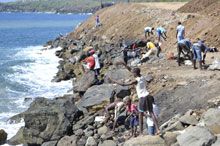What is bringing multitude of fish to waters at Stubbs Bay?

Over the past few months, the beach at Stubbs Bay has been experiencing a significant increase in activity â both on land and in the water.
Residents from Stubbs and other surrounding areas have been flocking to the beach in droves; not to witness the Sargassum seaweed that has been plaguing the coastline,{{more}} nor to chart the developments that construction on the Argyle International Airport has brought to the bay.
They have come to fish. And not just one or two â they have come to catch a lot of fish!
On any given day of the week (but mostly on weekends), scores of people can be found on the rocks, casting their home-made hand lines and reeling in a variety of fish from the sea. Although some persons have fished at this beach for many years, the bounty has never been this high.
One seasoned fisherman, St Augustine Joseph, squinted under the harsh midday sun as he proudly showed off all the fish he had caught earlier that day.
Speaking with SEARCHLIGHT last Sunday, September 27, Joseph â who is in his mid 50s â said that he has been fishing at Stubbs Bay since he was a young boy.
“Since I coming here, this de most fish I ever see people catching,â he mused. “Even dem who canât fish catching fish!â
Joseph said that whilst he mostly catches âbarbieâ fish, he has also caught cavali and âten inchâ, among others. He doesnât know what is responsible for the surge of fish in the area, but said that he intends to enjoy it while it lasts.
Another older fisherman, Alphonso Durrant â who lives in Calder â also showed SEARCHLIGHT his impressive catch, and boasted that on a previous fishing expedition the week before, he had caught over 45 fish.
Of the persons present at Stubbs Bay last Sunday, many explained that over the past few months, they have caught hundreds of fish, and will also continue to visit regularly to hook more.
One resident also told SEARCHLIGHT that shopkeepers in the area have complained about a marked decline in the sale of chicken since villagers have been reeling in fish by the dozens.
But aside from their obvious joy at the increase in fish, residents are baffled as to why they are suddenly so abundant in their waters.
One theory put forward by a construction worker, who is working on the international airport site, is that the fish have always been there; itâs just that the filling in of the land to accommodate the airport has brought people in closer contact with the fish.
He further posited that whereas fishermen would have had to use boats to fish in that particular area before, the expansion of the coastline has enabled more persons to access the fish.
Another theory is that the abundance of Sargassum seaweed along the coastline that has been plaguing St Vincent and the Grenadines (and the rest of the Caribbean region) since 2011 has created a nursery â a safe haven of sorts â that a variety of fish and other sea life have flocked to.
According to a press release issued by the Ministry of Natural Resources and Labour in the Virgin Islands (July 31, 2015), Sargassum seaweed has “many benefits and advantages to fisheriesâ.
The press release further stated: “Acting Deputy Chief Conservation and Fisheries Officer Mr. Mervin Hastings said that the Sargassum provides a nursery for many species of fish and is similar to a mangrove system, as mangroves are important nurseries for fish, crab, turtles and other marine creatures.â
According to research published by the Monterey Bay Aquarium Research Institute in September 2014, mats/rafts of Sargassum seaweed in a region of the North Atlantic Sea known as the Sargasso Sea had accumulated a “surprising varietyâ of fishes, snails, crabs and other small animals.
The research also pointed out that the South Atlantic Fishery Management Council has designated said Sargussum âraftsâ as “essential fish habitatsâ.
The study also acknowledged that marine life that exists within these large expanses of seaweed are “definitely changing,â along with temperatures, acidity levels and oxygen concentrations in seas and oceans around the world.
It further stated: “…detecting the biological effects of these long-term trends is a formidable challenge because animal communities can vary dramatically over short time periods.â
SEARCHLIGHT contacted the Fisheries Division in the Ministry of Agriculture, but was unable to garner from them a response or reason for the apparent increase in fish population at Stubbs Bay before going to print.











